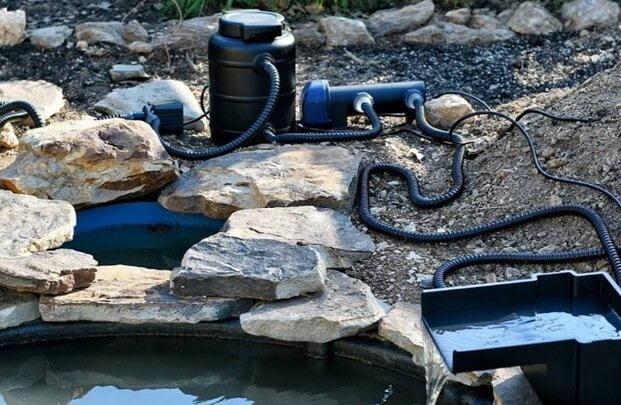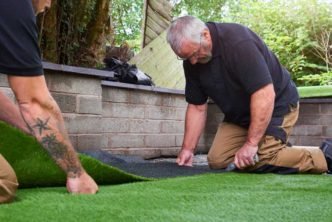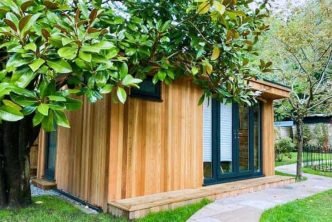The ecosystem of a garden pond depends heavily on the pump as it provides the water with the circulation it needs to stay healthy and oxygenated. As oxygen permeates the water, aquatic life can then thrive and survive. Plants benefit as well.
In addition to keeping the plant life and fish in your pond healthy, it allows you to create a more eye-catching water feature like a fountain, waterfall, or gentle rippling effect. And this will immensely improve the look of your garden.
That said, choosing the right pump for your pond is essential so that you and any aquatic residents can enjoy the feature to the fullest. A bad choice will provide poor water circulation, resulting in stagnation, algae buildup and mosquitos.
However, as you begin your search for the right pump, you may get a little confused about the various types available and the capabilities of each. To make the right decision, it’s crucial to know the different types and the conditions and places where they are most useful.
Table of Contents
Types

Pond pumps are essentially classified as external or submersible. Each category includes different types, so let’s check them out.
Submersible

Most pond pumps on the market are submersible, which means they operate below the water’s surface. In general, submersible options cost less and operate more quietly. While certain models advertise their ability to power multiple features simultaneously, you should proceed carefully because it can be difficult to power both a fountain and a flowing feature with the same unit.
Filter
They are referred to as filter pumps because this waste can be collected by filters. Most filter pumps for ponds can handle large solid waste and matter particles (4mm–12mm) by pumping them out and up the attached hose. These pumps can keep the water flowing nonstop, and despite having to work for long hours, modern technology now allows them to run efficiently year after year.
The most effective way to create water flow or to power a waterfall is with this type, even in situations where a filter system is not in use. Just make sure the model you choose is equipped with an Eco motor, which is more effective and costs less to operate. The fact that these types run continuously can add a lot to electricity costs.
High-Pressure
With high-pressure water pumps for ponds, you get a lot for your money. These have very high flow rates that gradually decrease as they push up to higher head heights. However, they’re not as dependable as filter types because they aren’t built to run continuously for a long time.
Many of these models are equipped with float switches, which ensure that the pump automatically shuts off if the water level drops to an insignificant level. Due to their affordability, they can be a great backup in an emergency case.
Fountain

This is what you need if you want to create a beautiful water display. Most fountain pumps with flow rates of more than 1000lph are equipped with a T-piece. This flow diverter allows the water to flow in two different ways, sending some of it to a waterfall and the rest to a fountain.
These types were once thought to be multipurpose. This was primarily due to the possibility of using some of the flow to produce a gorgeous fountain and the remainder to feed into a filter. But there was a serious problem with this concept.
The filter cage or holes surrounding the unit must be extremely small (typically 2-3mm). If the solids were any larger, they may pass through the impeller and be driven into the fountainhead, obstructing the fountain.
Due to debris quickly assembling on the cage, fountain pumps are unable to carry bigger solids through filters and their performance may be negatively impacted. It is advisable to employ fountain pumps solely for ornamental and display purposes.
External

External types are placed outside the pond. They need to be set up in a place that will protect them from the elements. The mechanical air pump is one frequently used external type.
You might have a fountain or a waterfall that you think adequately aerates the water. These features are generally enough to help improve the quality of the water as they do a great job at removing the least aerated portions of your pond’s bottom and pushing them up through the air to aerate it. However, some parts will always remain uncirculated.
With a mechanical air pump, you can distribute many air stones around the pond to increase circulation and oxygen levels at the same time. In other words, a fountain or waterfall will help to provide a beautiful display, circulation, and aeration; however, if the feature’s purpose is to aerate the water, you should put an air pump alongside it to fully aerate your pond.
These models are typically placed right next to the pond. You’ll find air pond pump models that are fairly weatherproof, but in general, they need to be kept nearby in a dry area, preferably in a large plastic box. They force air through an airline to the deepest water level where it is then pushed through a porous stone or wooden airstone to produce a stream of bubbles that allows the pond to be oxygenated. You can purchase manifolds that divide the airflow if you want to use one air pond pump to power multiple airstones scattered throughout,
Most air models work flawlessly when pumped to a depth of about 1 metre. Any more than that and some light to mid-range options might start to struggle, occasionally only producing the off bubble. The only thing you should check is that the model you purchase will provide you with a good flow rate at the depth you choose.
Solar Powered
External or submersible options can also be powered by solar energy. Since these are solar-powered, they are excellent for the environment and can help reduce your bills. These models are also extremely safe to use because they don’t use electricity. The only downside of is that they can only run when it’s warm and sunny.





